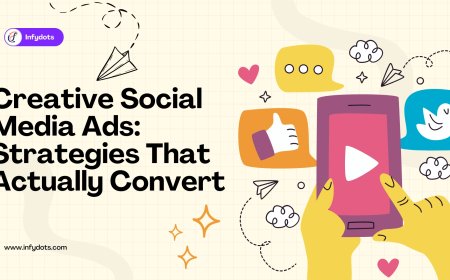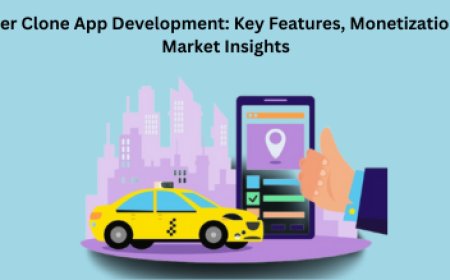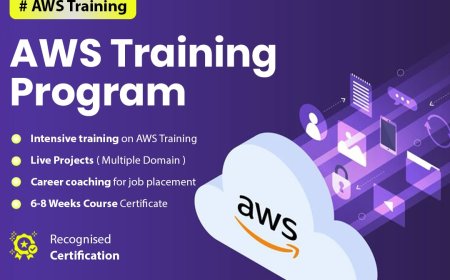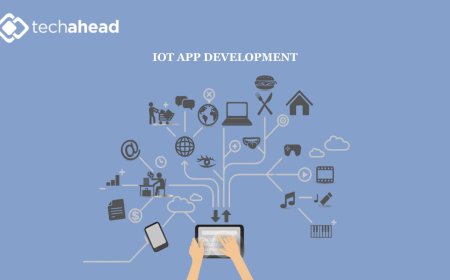A Guide to Leveraging Artificial Intelligence Development Services for Business Growth
Artificial Intelligence Development Services are professional offerings that enable organizations to build, deploy, and maintain AI-powered solutions tailored to their business needs.
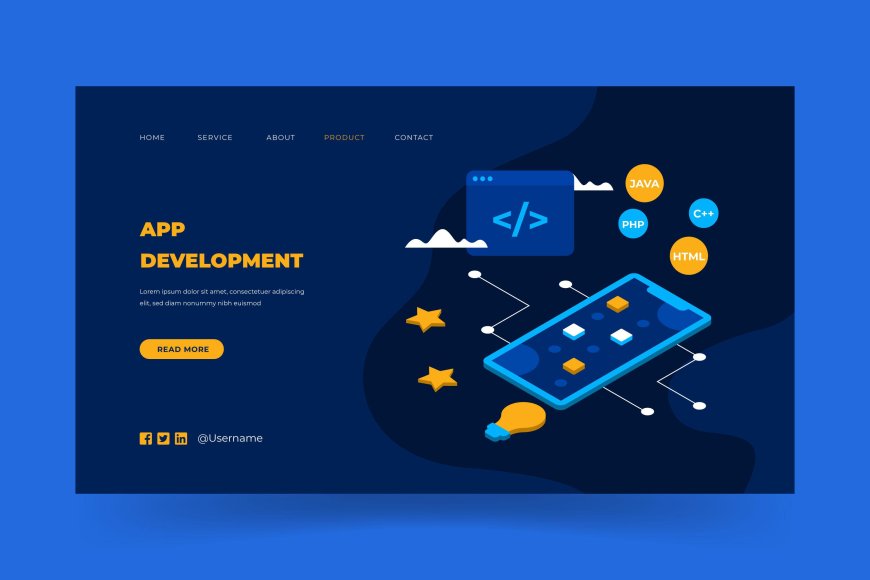
Introduction
Were living in the golden age of technological transformation, and artificial intelligence (AI) is leading the charge. From voice assistants and chatbots to intelligent analytics and automation, AI has moved from sci-fi fantasy to business reality. Today, companies are using AI to outthink competitors, streamline operations, and uncover new revenue opportunities.
But heres the catch: not all businesses know how to make the most of AI. Thats where artificial intelligence development services come into play. These specialized services help businesses not only adopt AI but also tailor it to meet unique operational needs. Whether you're a startup looking to disrupt your market or a mature enterprise striving to stay ahead, leveraging AI development services can fuel serious growth.
This guide will walk you through everything you need to know to harness AI for business successwhat services exist, how to implement them, what benefits to expect, and how to avoid common pitfalls. Ready to turn artificial intelligence into a strategic weapon for your business? Lets dive in.
What Are Artificial Intelligence Development Services?
Artificial Intelligence Development Services are professional offerings that enable organizations to build, deploy, and maintain AI-powered solutions tailored to their business needs. These services range from strategy and consulting to full-scale solution development, including training machine learning models, developing natural language interfaces, and integrating AI into existing workflows.
Heres a closer look at what they typically include:
- AI Strategy Consulting: Assessing your business goals and identifying opportunities for AI.
- Custom AI Software Development: Creating tailored solutions such as chatbots, recommendation engines, or fraud detection systems.
- Machine Learning Model Building: Training algorithms to make decisions based on your data.
- Natural Language Processing (NLP): Enabling machines to understand and respond to human language, useful for voice assistants or customer service bots.
- Computer Vision: Teaching machines to interpret and analyze images and videos.
- AI Integration Services: Embedding AI tools into your existing systems like CRM, ERP, or data analytics platforms.
- Ongoing Maintenance and Optimization: Continuously improving models based on performance and feedback.
Think of AI development services as your bridge from AI sounds cool to AI is powering my business growth. They translate complex technology into practical, profitable solutions.
The Strategic Role of AI in Business Growth
AI isnt just about cutting costsits about creating new value. In todays hyper-competitive landscape, companies that leverage AI can move faster, make smarter decisions, and offer better customer experiences. Thats a winning combination for business growth.
Lets break down a few ways AI drives real-world impact:
- Faster Decision-Making: AI can process and analyze massive amounts of data far quicker than any human team. This enables real-time insights, helping companies make proactive decisions rather than reactive ones.
- 24/7 Customer Support: AI-powered chatbots and virtual assistants can handle thousands of queries around the clock, reducing response times and freeing up human agents for complex issues.
- Product Innovation: Companies like Netflix and Spotify use AI to suggest content based on user behavior, enhancing engagement and satisfaction.
- Marketing Personalization: AI can segment audiences, predict customer behavior, and serve personalized ads, increasing ROI.
- Operational Efficiency: From automated inventory management to predictive maintenance, AI makes operations leaner and more agile.
Companies like Amazon, Google, and Tesla have long been using AI to push the boundaries of innovation. But today, thanks to AI development services, even small and medium businesses can access this power. The result? A more level playing field where tech-savvy businesses can punch above their weight.
Identifying Business Areas That Can Benefit from AI
You dont need to revamp your entire company overnight to benefit from AI. The smartest approach is often to start smallby identifying key areas where AI can make a measurable impact.
1. Sales and Marketing
AI can score leads, forecast sales, automate outreach, and personalize marketing messages. Tools like predictive analytics can help identify which prospects are most likely to convert, enabling smarter campaign strategies.
2. Customer Service and Support
Chatbots and virtual assistants reduce support loads while improving customer experience. AI-driven helpdesks can analyze queries and route them to the right agentor solve them outright.
3. Operations and Logistics
AI can optimize supply chain routes, manage inventories, and reduce operational downtime through predictive maintenance. It brings precision and foresight to logistics planning.
4. Finance and Accounting
From fraud detection and expense management to automating accounts payable and receivable, AI reduces manual work and improves accuracy.
The best part? Most businesses already generate the data needed for AI to work its magic. AI development services help you tap into that data to drive transformation.
Core AI Technologies Powering Business Transformation
To fully appreciate what AI can do for your business, its helpful to understand the core technologies behind the buzz. Each has its unique capabilitiesand choosing the right one depends on your specific needs.
Machine Learning (ML)
The backbone of most AI applications, ML allows systems to learn from data and improve over time. It powers everything from spam filters to product recommendations.
Natural Language Processing (NLP)
NLP enables machines to understand, interpret, and respond to human language. Think virtual assistants, chatbots, sentiment analysis tools, and automatic translators.
Computer Vision
This tech lets AI see the world. Its used for facial recognition, quality inspection in manufacturing, and even medical image diagnostics.
Predictive Analytics
Predictive models analyze historical data to forecast future trends. Its a powerful tool for demand planning, financial modeling, and customer behavior prediction.
When you work with AI development services, theyll help identify which technologies best suit your business goals. This ensures that your investment in AI delivers tangible value.
Benefits of Implementing AI Development Services
Implementing AI into your business isnt just about keeping up with trendsits about unleashing a new era of efficiency, insight, and opportunity. Businesses that have embraced AI development services often find themselves reaping numerous benefits that directly impact their bottom line and future growth.
1. Increased Efficiency and Automation
AI automates repetitive and time-consuming tasks, freeing up your human workforce to focus on higher-level strategic initiatives. Whether its processing invoices, answering routine customer questions, or analyzing datasets, AI handles it faster and more accurately than humans.
2. Enhanced Customer Experiences
Todays consumers expect personalized experiences and instant responses. AI helps businesses deliver just that. From intelligent chatbots to recommendation engines, AI ensures that your customers feel understood and valued at every interaction.
3. Better Decision-Making with Data Insights
AI systems analyze large volumes of data to provide insights that would take humans weeks to uncover. This helps in smarter decision-making, be it launching a new product, adjusting pricing, or optimizing supply chains.
4. Cost Reduction and Scalability
While the initial investment in AI might seem steep, the long-term savings are substantial. AI systems work 24/7, reduce error rates, and require minimal ongoing expenses. Plus, they scale easily as your business growsno need to constantly hire additional staff.
5. Competitive Advantage
In many industries, the early adopters of AI are now the market leaders. Businesses leveraging AI have an edge in speed, accuracy, and customer satisfaction. Its not just a toolits a differentiator.
By tapping into AI development services, you gain access to cutting-edge tools and strategies that can elevate your business from reactive to proactive, from manual to automated, and from stagnant to scalable.
Choosing the Right AI Development Partner
Your AI journey is only as successful as the partner you choose to walk it with. Picking the right AI development provider is a mission-critical decision that can either accelerate your growthor drain your budget with underwhelming results.
What to Look For:
- Proven Experience: Check for industry-specific case studies, client testimonials, and a strong portfolio. Experience with businesses similar to yours is a major plus.
- Technical Expertise: Are they fluent in modern AI languages and frameworks like Python, TensorFlow, PyTorch, and cloud platforms like AWS, Azure, and Google Cloud?
- End-to-End Capabilities: Great providers dont just build modelsthey help with strategy, integration, deployment, and ongoing optimization.
- Transparent Communication: Do they set realistic timelines and clearly explain technical details? Transparency builds trust.
- Focus on Customization: Cookie-cutter solutions rarely work. You want a partner who takes the time to understand your business and tailors AI accordingly.
Red Flags to Avoid:
- Overpromising results without data to back it up
- Lack of clear milestones or project roadmap
- No post-deployment support
- Minimal understanding of your industry
Choosing a partner isnt just about skillsits about alignment. The right provider will feel less like a vendor and more like a part of your team, working toward the same goals.
Steps to Successfully Integrate AI into Your Business
AI integration isnt something you do overnightits a structured process that requires planning, collaboration, and iteration. When done right, it sets the stage for lasting business transformation.
Step 1: Define Objectives
Before jumping into development, get crystal clear on what you want AI to achieve. Is it improved customer service? Faster inventory management? Fraud detection? Align AI goals with your broader business strategy.
Step 2: Prepare Your Data
Data is the fuel for AI. Ensure your data is clean, organized, and relevant to the problem youre trying to solve. You may need help structuring or labeling data for supervised learning models.
Step 3: Develop and Train the Model
This is where the magic happens. Your AI development partner will build and train the model using historical data, continuously testing and refining it to improve performance.
Step 4: Test and Deploy
Before full deployment, rigorous testing ensures the model performs well in real-world scenarios. Once validated, the AI system is integrated into your existing software environment.
Step 5: Monitor and Improve
AI isn't static. It learns and evolves with time. Ongoing monitoring helps fine-tune the model, fix bugs, and ensure it adapts to changes in business conditions or customer behavior.
By following these steps and working with a skilled partner, you can transform AI from a concept into a real asset driving your business forward.
Custom AI Solutions vs. Pre-Built Tools
When looking to integrate AI into your business, youll often face this crucial decision: Should you opt for a custom-built AI solution or use a pre-built tool? The answer depends on your business needs, budget, and long-term goals.
Custom AI Solutions
These are built from scratch to solve your unique problems using your specific data.
Pros:
- Tailored to your business needs
- Better integration with existing systems
- More scalable and adaptable
Cons:
- Higher upfront costs
- Longer development time
Pre-Built Tools
These are plug-and-play solutions designed for general use cases (think chatbot platforms or AI writing tools).
Pros:
- Faster deployment
- Lower initial cost
- Easy to use
Cons:
- Limited customization
- May not address complex or niche problems
- Integration challenges
If your needs are straightforward and time-sensitive, pre-built tools might suffice. But for businesses aiming to innovate or solve complex challenges, custom AI is the smarter, more strategic choice. AI development services help you decide which path offers the best ROI and scalability.
Common Challenges in AI Integration
Even with the best intentions, many AI projects stumble due to avoidable challenges. Knowing what to expect can help you prepare and avoid common roadblocks.
1. Data Quality and Availability
AI systems need clean, complete, and relevant data. Incomplete or biased datasets lead to poor performance or unfair results. Data cleaning and preparation often take more time than model training itself.
2. Change Management
AI changes how work gets doneand that can make employees uneasy. Resistance to change is natural. Without proper change management, training, and communication, adoption can be slow or unsuccessful.
3. Technical Complexity
AI is complex. Without the right expertise, businesses may struggle with implementation, integration, or even understanding how the model works. Thats why choosing a knowledgeable AI partner is so important.
4. Unrealistic Expectations
AI isnt magic. It requires time, iteration, and effort. Expecting a fully functional solution overnight leads to disappointment and misaligned goals.
The good news? All these challenges can be mitigated with good planning, communication, and the right guidance from experienced professionals.
Budgeting and ROI for AI Projects
Budgeting for AI is often one of the biggest concerns for business leaders. While AI solutions can seem costly at the outset, the long-term ROI they generate typically outweighs the initial investment. The key lies in understanding cost structures and measuring value correctly.
Understanding Cost Factors:
- Scope of the Project: A simple chatbot costs far less than a fully integrated AI-driven analytics system.
- Data Needs: Costs increase if your data is messy, unstructured, or requires significant preprocessing.
- Customization Level: Tailored solutions cost more than off-the-shelf products but deliver higher returns.
- Deployment Complexity: If AI needs to integrate with legacy systems, expect additional development and support costs.
- Ongoing Support: AI requires continual training and monitoring. Budget for post-launch maintenance and model updates.
Measuring AI ROI:
- Cost Savings: How much manual work has AI replaced? How many hours are saved monthly?
- Revenue Growth: Has AI led to better conversion rates, upselling, or customer retention?
- Process Improvement: Has AI reduced bottlenecks, errors, or delays in your workflows?
- Customer Experience: Are customers more satisfied due to faster service or personalized interactions?
AI is an investment, not an expense. Businesses that focus on long-term goalsrather than short-term costsreap substantial benefits. Smart budgeting and a focus on clear KPIs help ensure your AI project delivers a solid return.
AI Use Cases Across Industries
Artificial intelligence is industry-agnostic. From agriculture to aerospace, AI has proven its value in driving innovation and performance. Lets explore how different sectors are leveraging AI development services in 2025.
1. Healthcare
- AI assists in disease diagnosis using image recognition.
- Chatbots help with patient pre-screening and appointment scheduling.
- Predictive analytics improve patient care and hospital resource allocation.
2. Retail and E-Commerce
- Personalized product recommendations boost sales.
- AI chatbots manage 24/7 customer service.
- Inventory and demand forecasting enhance supply chain management.
3. Manufacturing
- AI-driven robotics handle precision-based production tasks.
- Predictive maintenance reduces equipment downtime.
- Computer vision systems conduct quality control in real time.
4. Financial Services
- Fraud detection models flag suspicious transactions instantly.
- AI chatbots assist customers with account information and issue resolution.
- Algorithms help with credit scoring and loan approvals.
5. Education
- AI tutors adapt learning materials to individual student needs.
- Admin tasks like grading and enrollment are automated.
- Predictive systems identify at-risk students for early intervention.
These examples show that no matter your industry, theres likely an AI use case waiting to be exploredand monetized.
Future Trends in AI Development Services
AI is evolving rapidly. As we look beyond 2025, several trends are reshaping how businesses will use and adopt artificial intelligence development services.
1. Democratization of AI
AI is no longer just for tech giants. Tools like AutoML and no-code platforms are making AI accessible to non-technical teams and small businesses, allowing wider adoption and faster innovation.
2. Rise of Generative AI
Generative AIlike GPT, DALLE, and othersis transforming content creation, software development, and even design. Expect more businesses to use AI to generate marketing copy, images, code, and beyond.
3. Emphasis on Responsible AI
With increasing scrutiny around bias and ethical concerns, companies are focusing on responsible AI practices. This includes transparency, explainability, and fairness in algorithmic decisions.
4. Integration with IoT and Edge Computing
AI is moving closer to where data is generatedon devices and sensors. Edge AI enables faster decisions with lower latency, especially in industries like manufacturing, logistics, and smart cities.
5. AI-Driven Personalization
From product recommendations to dynamic pricing, businesses are leveraging AI to personalize every aspect of the customer journey, making it a standard expectation rather than a premium feature.
Businesses that stay ahead of these trends will not only future-proof their operations but also gain a significant edge over competitors.
Tips to Maximize the Impact of AI in Business
AI success isnt just about having the right toolsits about how you use them. Here are proven strategies to help you maximize the impact of your AI investments.
1. Start Small, Scale Fast
Begin with pilot projects that address specific problems. Once validated, scale those solutions across departments or markets.
2. Involve Cross-Functional Teams
AI impacts multiple parts of the organization. Involve IT, operations, marketing, and finance to ensure alignment and maximize adoption.
3. Foster a Data-Driven Culture
AI thrives on data. Encourage teams to prioritize data quality, and make data literacy a core business skill across departments.
4. Invest in AI Literacy
The more your employees understand AI, the better theyll be at adopting and leveraging it. Training programs and workshops can go a long way.
5. Collaborate with the Right Partners
Whether youre building in-house or outsourcing, choose collaborators who understand both the technology and your business. Communication, transparency, and a shared vision are essential.
The true power of AI comes from integrating it deeply into your operations, not just treating it as a side project.
Conclusion
Artificial intelligence is no longer a futuristic luxuryits a present-day necessity for businesses aiming to thrive in the digital economy. By leveraging best AI development services, companies of all sizes cantap into the enormous potential of automation, personalization, and data-driven decision-making.
From identifying opportunities to choosing the right partner, from managing change to tracking ROI, this guide has walked you through every step of the journey. AI isnt just about tech; its about transformation. Businesses that act now will not only keep upbut lead.
Dont just adapt to the future. Shape itwith AI.
FAQs
1. How long does AI development take?
It depends on the complexity of the project. A basic AI solution may take 612 weeks, while more complex, customized models can require 612 months.
2. Can small businesses benefit from AI?
Absolutely. AI tools and services are becoming more affordable and accessible, with many solutions designed specifically for small and medium enterprises.
3. Is AI secure for handling sensitive data?
Yes, if implemented correctly. Choose partners who follow strict data privacy regulations like GDPR and use encryption and access controls.
4. What industries use AI the most?
Healthcare, retail, finance, manufacturing, education, and logistics are currently among the top industries leveraging AI technology.
5. How do I choose the right AI provider?
Look for providers with industry experience, technical expertise, transparent processes, and a portfolio of successful projects. Always ask for references and case studies.














